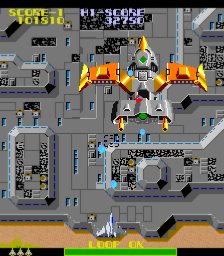Re: [新聞] (WIP) Luca's MAME Drivers (13/08/23)
作者: conpo (獅子たちの旗) 2014-04-18 15:26:12
2014.04.17
STG名作Wyvern F-0將於0.154支援。
Rejoice! The crazy-rare Wyvern F-0 vertical shooter by Taito is finally
in MAME, Guru dumped the ROMs, the game is preserved. It was a long time
coming.
I remember very clearly reading about it on the Italian magazine
Videogiochi (No. 31, pp. 62-63) back in 1985. It was mis-labeled as
"Wyvern FQ" due to the title logo graphics, as you can see from the
flyer (from The Arcade Flyer Archive):
![]()
Much of the appeal, and rarity, of Wyvern F-0 comes from the dedicated
cabinet it uses. The game boards produce two separate video outputs
that are sent to two different screens housed in the cabinet. A
half-silvered mirror is used to mix the images from the two screens in
such a way as to produce a pseudo-3D effect. Backgrounds and enemies on
the ground are displayed in the lower screen, while player ship and
enemies in the air are displayed in the upper screen. These appear to
be at different depths to the eyes of the player, thus giving the
illusion of sprites in the air floating above the ground.
To further enhance the effect, the cabinet also has two speakers. The
sound of enemies on the ground is heard from the bottom speaker, while
the sound of enemies in the air is heard from the top speaker.
Here are some cabinet photos taken from this site:
![]()
![]()
![]()
That said, it does appear to be possible to run the game on a standard
cabinet with single monitor, as shown here:
![]()
As for the game, it's essentially an updated version of Namco's Xevious,
including the distinctive target for bombing the ground, using the
second button, with a few other elements also borrowed from classics of
the era. For instance the third "loop" button from Capcom's 1942, used
to quickly get out of troubles, is implemented here with an additional
gauge at the bottom of the screen that gets replenished with time.
Another not so common feature is the ability to control the vertical
scroll speed by moving your ship towards the top (faster) or the bottom
of the screen (slower).
End-of-level bosses (one of the novel features of Xevious) are rather
easy to defeat by bombing one to three weak spots or will simply fly
away after a set time, in that case replacing the next level boss.
Enemy shots can be intercepted by the player's, which I believe is
rather unusual. Power-ups, e.g. a fire enhancing pod or a shield can
be obtained by bombing ground targets, including a few hidden ones like
in Xevious.
Here are some shots from MAME, note that some sprites have wrong colors:
![]()
![]()
![]()
(圖多懶得po,請至來源處瀏覽)
https://www.youtube.com/watch?v=TUVeU0RnIGc&feature=player_embedded
MAME executable(Windows x64) freshly compiled to include the driver.
http://www.sendspace.com/file/bj7u5f
Hardware-wise, this is typical mid-80's Taito hardware spread over 4
PCBs: a CPU board (Z80 + protected 68705P5 MCU), a sound PCB (Z80, 2
x YM2149, OKI MSM5232) plus a video board and a rom board with just
common logic (no custom chips). Sprites are 32x32 and use 4 8x8 tiles
with a look-up table in RAM holding the actual tile indexes. Plus a
background and a text tilemap:
![]()
The MCU, used for protection and not easily dumpable, is simulated only
in the boot phase. I've spotted no obvious in-game issues in the limited
playing I've done, and in some instances the values read from the MCU
are indeed discarded by the game code. Alas, subtle or major issues
under specific conditions are indeed possible.
The music has a recognizable character to it thanks to the excellent
8-channel MSM5232 sound chip. The soundtracks can be found on the Taito
Music Collection CD:
![]()
______________________________________________________________________________
來源:http://www.lucaelia.com/mame.php/2014/Wyvern-F-0
STG名作Wyvern F-0將於0.154支援。
Rejoice! The crazy-rare Wyvern F-0 vertical shooter by Taito is finally
in MAME, Guru dumped the ROMs, the game is preserved. It was a long time
coming.
I remember very clearly reading about it on the Italian magazine
Videogiochi (No. 31, pp. 62-63) back in 1985. It was mis-labeled as
"Wyvern FQ" due to the title logo graphics, as you can see from the
flyer (from The Arcade Flyer Archive):

Much of the appeal, and rarity, of Wyvern F-0 comes from the dedicated
cabinet it uses. The game boards produce two separate video outputs
that are sent to two different screens housed in the cabinet. A
half-silvered mirror is used to mix the images from the two screens in
such a way as to produce a pseudo-3D effect. Backgrounds and enemies on
the ground are displayed in the lower screen, while player ship and
enemies in the air are displayed in the upper screen. These appear to
be at different depths to the eyes of the player, thus giving the
illusion of sprites in the air floating above the ground.
To further enhance the effect, the cabinet also has two speakers. The
sound of enemies on the ground is heard from the bottom speaker, while
the sound of enemies in the air is heard from the top speaker.
Here are some cabinet photos taken from this site:



That said, it does appear to be possible to run the game on a standard
cabinet with single monitor, as shown here:

As for the game, it's essentially an updated version of Namco's Xevious,
including the distinctive target for bombing the ground, using the
second button, with a few other elements also borrowed from classics of
the era. For instance the third "loop" button from Capcom's 1942, used
to quickly get out of troubles, is implemented here with an additional
gauge at the bottom of the screen that gets replenished with time.
Another not so common feature is the ability to control the vertical
scroll speed by moving your ship towards the top (faster) or the bottom
of the screen (slower).
End-of-level bosses (one of the novel features of Xevious) are rather
easy to defeat by bombing one to three weak spots or will simply fly
away after a set time, in that case replacing the next level boss.
Enemy shots can be intercepted by the player's, which I believe is
rather unusual. Power-ups, e.g. a fire enhancing pod or a shield can
be obtained by bombing ground targets, including a few hidden ones like
in Xevious.
Here are some shots from MAME, note that some sprites have wrong colors:



(圖多懶得po,請至來源處瀏覽)
https://www.youtube.com/watch?v=TUVeU0RnIGc&feature=player_embedded
MAME executable(Windows x64) freshly compiled to include the driver.
http://www.sendspace.com/file/bj7u5f
Hardware-wise, this is typical mid-80's Taito hardware spread over 4
PCBs: a CPU board (Z80 + protected 68705P5 MCU), a sound PCB (Z80, 2
x YM2149, OKI MSM5232) plus a video board and a rom board with just
common logic (no custom chips). Sprites are 32x32 and use 4 8x8 tiles
with a look-up table in RAM holding the actual tile indexes. Plus a
background and a text tilemap:

The MCU, used for protection and not easily dumpable, is simulated only
in the boot phase. I've spotted no obvious in-game issues in the limited
playing I've done, and in some instances the values read from the MCU
are indeed discarded by the game code. Alas, subtle or major issues
under specific conditions are indeed possible.
The music has a recognizable character to it thanks to the excellent
8-channel MSM5232 sound chip. The soundtracks can be found on the Taito
Music Collection CD:

______________________________________________________________________________
來源:http://www.lucaelia.com/mame.php/2014/Wyvern-F-0
繼續閱讀
Re: [閒聊] 10款胎死腹中的遊戲conpo[求助]yabause 玩光明與黑暗3-王都的巨神會黑屏dog0505Fw: [閒聊] 史上最弱隱角兼惡搞王:火引彈shiuichi[閒聊] 索尼賣股票惹 OPWaug[分享] 七龍珠Zmugenprotect6090[公告] alwaysOrz 警告一次conpo[新聞] Gsdx-Cutie插件 2014/04/24choan[閒聊] 最暢銷遊戲 TOP 36,你花錢貢獻過幾款呢?conpo[新聞] (DS for Android) DraStic DS 2.2.1.2aconpo[新聞] (PS2) Play! Git (2014/04/16)conpo